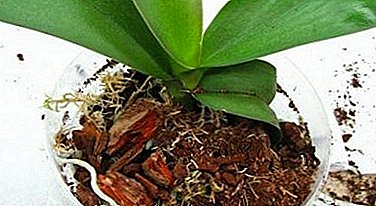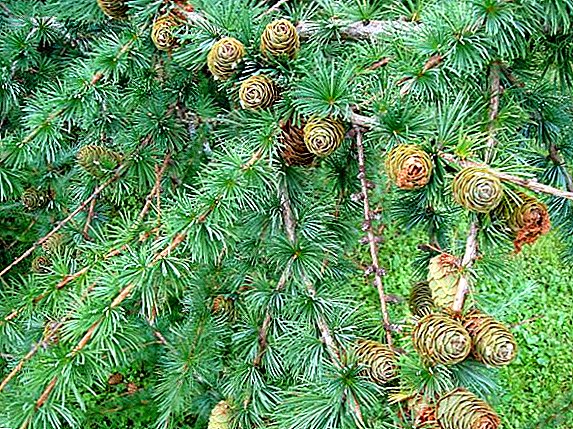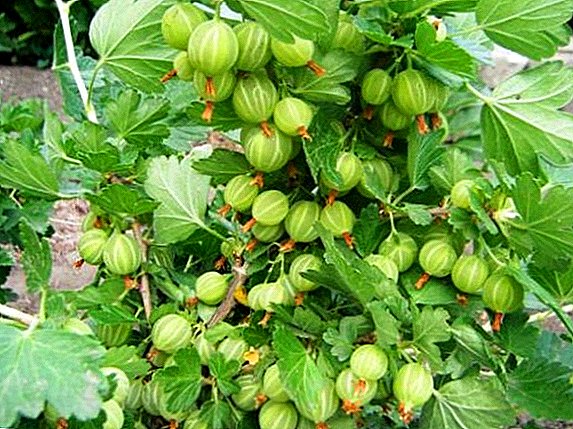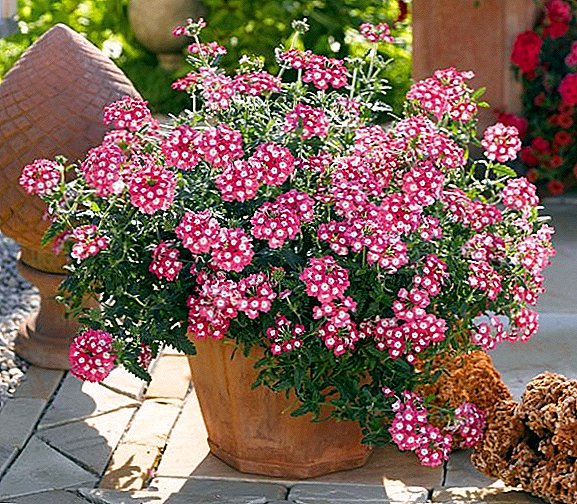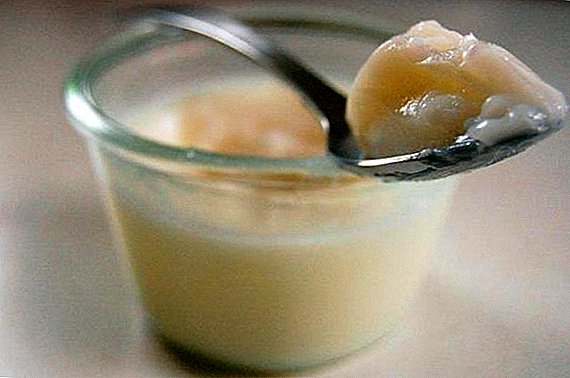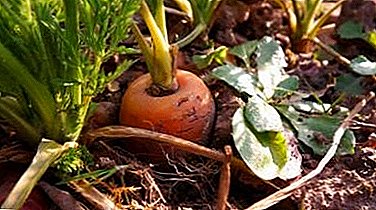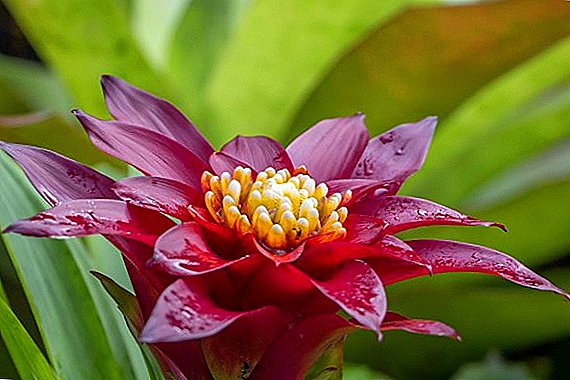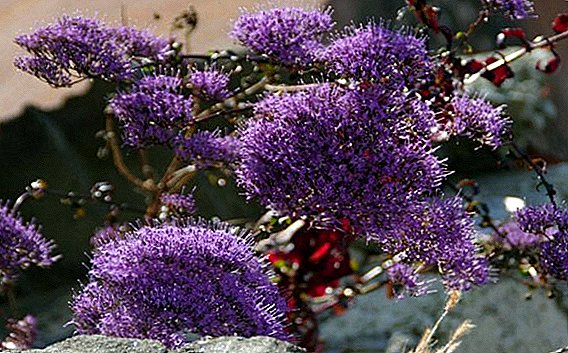 The graceful, beautiful and unusual trachelium attracted and attracts the attention of subtle charm. It is a reminder of how the gardens were decorated in past centuries, when this flower was very popular. Perhaps that is why in flower arrangements he usually creates a beautiful background, not acting as their center.
The graceful, beautiful and unusual trachelium attracted and attracts the attention of subtle charm. It is a reminder of how the gardens were decorated in past centuries, when this flower was very popular. Perhaps that is why in flower arrangements he usually creates a beautiful background, not acting as their center.
Description
This plant has been known since antiquity. The word "trachelos" in Greek means "throat." It clearly contains an allusion to the fact that the trachelium is capable not only of pleasing its beauty.  He can still cure colds and other problems associated with throat. However, in the nineteenth century, trachelium was popular precisely as an ornamental plant. For a long time, he was almost forgotten, but now he is once again gaining fame.
He can still cure colds and other problems associated with throat. However, in the nineteenth century, trachelium was popular precisely as an ornamental plant. For a long time, he was almost forgotten, but now he is once again gaining fame.
Trachelium loves the sun very much. And although his birthplace is the Mediterranean, it is also growing in the hot African continent.
The most famous colors of trachelium are blue (blue) and purple. Hybrid varieties can have a white, fiery red or pink color. Its use is diverse - and in flower compositions, and as a rabatka, and as a separate flower bed.
Did you know? A young man in the 19th century, who gave a girl a bouquet of trachelium, hinted to her about his special attitude and vision of her exceptional virtues.
 Trachelium belongs to the Kolokolchikov family. The flowers are small, gathered in fairly large and fluffy inflorescences, the shape of each resembles a small bell with five petals. They are located at the top of the stem.
Trachelium belongs to the Kolokolchikov family. The flowers are small, gathered in fairly large and fluffy inflorescences, the shape of each resembles a small bell with five petals. They are located at the top of the stem.By Kolokolchikovym also include Lobelia ampelnaya, bell peach.
The effect of "fluffiness" is created by highly elongated ovary tubes. The leaves are large (5-10 cm long) and oblong, the stem is straight, its height does not reach a meter. The leaves grow along the entire length of the stem.
If the trachelium is planted in open ground, then it begins to bloom in August. If in greenhouses - in March. The flowering period is long - several months. Planting open ground delight the eye before the first frost.
In addition to beauty, this flower fills the garden with aroma - trachelium flowers smell strong and pleasant. After flowering fruits appear - small black seeds, as if packed in a transparent box.  Both blooming and fruiting in trachelium occurs once a year.
Both blooming and fruiting in trachelium occurs once a year.
Kinds
There are three types of this plant: blue, ash, zhaken.
- Blue (Trachelium caeruleum) - the most common type of trachelium in our climate. Sometimes it is also called blue. This is the tallest member of this family. But, contrary to the name, it can be white, burgundy, and purple. True, this applies only to varietal plants.

- Ashberry (T. asperuloides) - The bush itself is small, similar to a vegetable hummock. Tender-purple inflorescences, as a rule, reach 10-15 cm in diameter. There are exceptions - the flowers are twice as large.

- Jaken (T. jacquinii) - dwarf variety of flower. The height of the bush is a maximum of 35 cm. But the flowers themselves are champions in length among the types of trachelium, they reach 1-1.5 cm. The color is pale blue.

All other types of hybrid. The most popular are Jemmy, WhiteUmbrella, BlueVeil.
- Jemmy - very dense shrub with very few foliage and many inflorescences of white, lilac, soft pink and purple flowers.
- Blueveil - The height of the bush up to 80 cm, blooms lilac.

- Whiteumbrella - "White umbrella" - this is how its name is translated, eloquently speaking about the shape and color of this hybrid.

Did you know? The name of the most popular type, the word "caeruleum ", Translated from Latin means "blue", indicating the color of the plant, although the shades of this color can be very different.
Breeding
There are two ways of trachelium reproduction - by seeds and division.
Such seeds as orchid, geykhera, kampsis, uvulyaria, azalea, tricyrtis, heliopsis are propagated by seeds and division.
Seeds are sown in loose moist soil, slightly pressing, but not sprinkling with earth. For quick germination, the tray is covered with a transparent film with holes and placed on a sunny window sill.
The best time for sowing is from late February to March. After 2-3 weeks, the seeds will germinate. When the third leaf appears on the stem, pinch the top of the plant so that it grows in breadth.  Reproduction by division is made from an adult plant, whose age is 2-3 years. From him separated "baby", which already has its roots. All this should be done carefully so as not to harm either the adult plant or the "baby."
Reproduction by division is made from an adult plant, whose age is 2-3 years. From him separated "baby", which already has its roots. All this should be done carefully so as not to harm either the adult plant or the "baby."
Sections for disinfection process copper sulphate, crushed coal or ash.
Learn how to use copper sulfate and charcoal in horticulture.
Planting and care, wintering features
The seedling is almost ready for planting in open ground at the end of May. This is usually done at a time when it is already warm outside and the earth is warm enough - up to 18-20 ° C.
"Delenka" transplanted into a separate, pre-cooked hole. It should be shallow. Moisturize the ground before planting. After the delenka is planted, the ground around the stem is lightly tamped and watered again.  This breeding method is more simple and effective. Trachelium usually quickly takes root in a new place and begins to bloom.
This breeding method is more simple and effective. Trachelium usually quickly takes root in a new place and begins to bloom.
The optimal distance between future bushes is about 30-40 cm. These ornamental bushes prefer flower beds located on the south side. The penumbra is also well tolerated. Neutral or weak acid soils are suitable; You can use a mixture of peat and sand.
Learn about the importance of soil acidity, how to determine acidity, how and how to deoxidize the soil.Drainage is also necessary to avoid stagnant moisture in the soil. With irrigation you need to be cautious - the plant does not tolerate both waterlogging and drought. Watering is necessary every 2-4 days. But weeding and weeding the soil, it welcomes.
At the peak of the summer heat accounted for the most abundant flowering. At high temperatures, trachelium feels great - a Mediterranean origin. 
Important! Charming trachelium requires compliance with safety regulations: working with it without protective gloves, you can get dermatitis.
Before flowering fertilized once a month. During the flowering period - once every two weeks. For this, any mineral fertilizer for flowering plants, diluted with water to the concentration indicated on the package, is suitable.
Mineral fertilizers include Plantafol, Azofoska, Sudarushka, Kristalon, Ammophos, Kemira.
Saltpetre will fit - 1 tbsp. spoon to 10 liters of water. 10 days after the first feeding, a second solution of superphosphate is carried out (25 g per bucket of water). In winter, when the trachelium is at rest, no fertilizer is needed.
This heat-loving plant can survive frosts down to -9 ° С. If the temperature drops, the ornamental bush runs the risk of becoming an annual. To save trachelium, it must be transplanted into a pot with a lump of earth and brought into the house.  Then wintering will be comfortable, and in summer fragrant and colorful inflorescences will continue to decorate flower beds or gardens.
Then wintering will be comfortable, and in summer fragrant and colorful inflorescences will continue to decorate flower beds or gardens.
Diseases and pests
The greatest enemy of this beautiful plant is moisture, which inevitably leads to rotting of the roots and basal neck, as well as to fungal diseases. To avoid this, you need to temper or even temporarily cancel watering at high humidity and loosen the ground for air access and drainage.
In rainy summer, it is recommended to spray the planting with a special solution that can be purchased at the store (for example, with the growth stimulator "HB-101", containing a variety of nutrients).
Another attack - parasites, spider mites and aphids. Their attacks are not adults, but growing shoots.  Salvation in insecticides and solution of a laundry soap. Grate 300 g of soap, add 2 liters of warm water and dissolve the soap.
Salvation in insecticides and solution of a laundry soap. Grate 300 g of soap, add 2 liters of warm water and dissolve the soap.
To insecticides include drugs such as "Fastak", "Decis", "Marshal", "Alatar", "Vertimek".
Then bring cold water to 10 liters. And this mixture to spray bushes.
For these purposes, you can use wood ash: a couple of handfuls of ash must be added to the already prepared soap solution. This irritates insect covers, and they leave the plant alone.
To get rid of spider mites, soap solution is also suitable. And he is afraid of rosemary. 5-10 drops of essential oil per 1 liter of water will save from this pest. 
Important! To young plants did not get sunburn, they must be placed under a canopy or cover with agrofibre.
Trachelium will bring not only brightness and beauty into the garden, but also a nostalgic touch and flavor. It is one of those colors that create an atmosphere - sophistication, taste and good mood. And since caring for him is not difficult, even though he came from hot countries, this plant will not become a burden for you.


